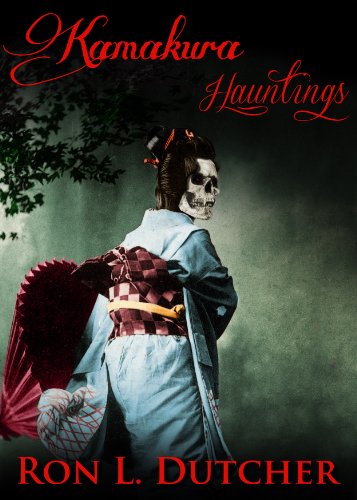Win a Free Trip to Japan!
Experience cherry blossoms and ancient temples
Kamakura, a city steeped in rich history and folklore, holds a captivating tale that intrigues both locals and visitors alike—the ghost of Kamakura. This ethereal figure not only weaves through traditional narratives but also plays a significant role in shaping the cultural identity of the region. As we delve into its intriguing legends, reported sightings, and the enduring impact on local culture, we uncover the mystery that continues to haunt Kamakura. Join us on this exploration of the ghost of Kamakura and its fascinating legacy that transcends time.
The history of the Ghost of Kamakura
The ghost of Kamakura weaves a fascinating tale that dates back centuries. This spectral figure is often associated with the tragic events surrounding the Kamakura period (1185-1333) in Japan, particularly during the conflicts between Samurai clans and the rise of the Kamakura shogunate. Local legends suggest that the ghost embodies a soul who suffered a deep injustice or met a violent end.
Key Historical Points:
- The Kamakura period: This era signifies Japan’s feudal age characterized by the rule of military leaders and turbulent power struggles.
- Significant events: Many believe that the unrest and violence of the time contributed to the emergence of numerous vengeful spirits, including the ghost of Kamakura.
Folklore Origins:
- Stories from locals: Over generations, tales have circulated of a woman appearing near the temples and shrines, dressed in traditional clothing, whose mournful wails echo through the night.
- Historical figures: Some even speculate that the ghost may represent a specific historical figure—a person wronged or betrayed, crystalizing the pain of the past.
Thus, the ghost of Kamakura has evolved from historical events into a vital part of local folklore, embodying the sorrow and struggles of a bygone era. Its history not only captivates those interested in the supernatural but also reflects the rich tapestry of Japan’s cultural heritage.

Legends and Folklore Surrounding the Ghost of Kamakura
The ghost of Kamakura is steeped in rich legends that offer insight into the local culture and beliefs. Various stories intertwine, depicting the haunting presence in a tapestry of supernatural intrigue. Here are some of the most notable legends associated with this enigmatic spirit:
- The Vengeful Samurai: Some tales suggest that the ghost of Kamakura is the spirit of a samurai wronged in battle. He seeks revenge on those who betrayed him, symbolizing loyalty and honor in Japanese culture.
- A Weeping Woman: One prominent legend describes a woman who lost her child to a tragic accident. Her sorrowful wails resonate through the night, as she searches for her lost offspring. This notion highlights the theme of love transcending death.
- The Haunted Shrine: Many locals claim that the Kamakura Shrine is a hotspot for paranormal activity. Visitors have reported inexplicable phenomena, such as strange sounds or fleeting shadows, fostering the belief that the ghost of Kamakura lingers there.
- The Ghostly Warning: Another tale tells of a traveler warned by the ghost of Kamakura about impending danger. This figure represents both protector and harbinger, showcasing the dual nature of spirits in folklore.
Exploring these legends allows one to grasp the deeper meaning of the ghost of Kamakura, which remains a topic of fascination and reverence in the region.
Key Locations Associated with the Ghost of Kamakura
The ghost of Kamakura is intertwined with several notable locations that enhance its mystique. Exploring these sites provides a deeper understanding of the ghost’s lore and significance in Japanese culture. Key locations include:
-
Kamakura Daibutsu (Great Buddha)
- A majestic bronze statue where many believe the ghost of Kamakura wanders, especially during twilight. Visitors often report eerie sensations near this historic site.
-
Hase-dera Temple
- Known for its serene atmosphere, this temple is another hotspot for ghost sightings. The temple’s deity, Kannon, is said to offer protection against malevolent spirits, adding to the allure.
-
Tsurugaoka Hachimangu Shrine
- This prominent shrine hosts many festivities associated with local legends, making it a focal point for tales of the ghost of Kamakura. Locals claim that whispers have been heard during rituals.
-
Yuigahama Beach
- As a serene backdrop, this beach appears in ghost tales. Visitors often experience unexpected chills after sunset—perhaps the presence of the ghost of Kamakura lingering nearby.
These locations not only serve as prime spots for ghost hunters but also offer a rich tapestry of history and cultural significance. Each site provides a unique lens through which to view the enigmatic ghost of Kamakura, bridging the past with the present in this ancient locale.
The Impact of the Ghost of Kamakura
The ghost of Kamakura profoundly influences local culture, shaping traditions, festivals, and daily life in this historic city. Here’s how this enigmatic figure has woven itself into the cultural fabric:
- Festivals and Celebrations: Each year, Kamakura holds events that honor the ghost of Kamakura, attracting both locals and tourists. The rituals often include lantern-lighting ceremonies, storytelling sessions, and special food offerings, all meant to appease the spirit.
- Local Art and Literature: The ghost of Kamakura inspires various artistic expressions. Artists and authors draw upon the ghost’s legends, creating paintings, poems, and novels that explore themes of love, loss, and the supernatural. Local workshops even encourage residents to interpret these stories through their artwork.
- Guided Tours: A burgeoning industry of ghost tours offers visitors opportunities to explore the mystery surrounding the ghost of Kamakura. Local guides recount chilling tales in historic locations, fostering a deeper appreciation of the city’s haunted heritage.
- Community Identity: The lore surrounding the ghost of Kamakura fosters a unique local identity, uniting inhabitants in shared stories. This sense of community pride draws attention to Kamakura’s rich history and cultural heritage.
The ghost of Kamakura does not merely exist as a tale; it actively shapes local customs, art, and community engagement, making it an integral part of Kamakura’s identity.

Sightings and Experiences Reported by Locals
The ghost of Kamakura has woven itself into the fabric of the local community, with many residents claiming to have encountered this spectral presence. Reports of sightings often feature a mixture of awe and trepidation, contributing to the ghost’s enigmatic allure.
Common Themes in Sightings:
- Time of Day: Most sightings occur at dusk or during the night, amplifying the eerie atmosphere.
- Locations: Witnesses often spot the ghost near historical sites such as temples and shrines. These locations enhance the supernatural feel of the experiences.
- Physical Description: Locals describe the ghost of Kamakura as a figure shrouded in a flowing robe, often with long hair, leaving an impression of sadness.
Testimonials from Locals:
- Old Man Tanaka: "I saw her near Hase-dera Temple one evening. She looked lost, gazing into the horizon."
- Young Tourist Muffin: "At midnight, we felt a chill and heard whispers while walking on the beach. It felt as if someone was guiding us."
- Shopkeeper Aiko: “Every year, I place offerings at the shrine. Locals swear they hear soft weeping when the moon is full.”
These experiences reflect a blend of cultural reverence and curiosity about the ghost of Kamakura. For many, these sightings foster a deeper connection to their history and traditions, ensuring that the ghost remains a vibrant part of local folklore.
Theories Explaining the Ghost’s Origin
The ghost of Kamakura has captivated the imagination of locals and tourists alike, leading to numerous theories regarding its mysterious origins. Here are some of the most prominent explanations:
- Historical Tragedy: Many believe that the ghost of Kamakura stems from a tragic figure who suffered injustice or violence. This theory emphasizes the emotional weight of past events, suggesting that unresolved pain remains tethered to the physical world.
- Cultural Haunting: Some scholars argue that the ghost of Kamakura represents a deeper cultural manifestation, rooted in the Japanese belief in spirits (yūrei). These spirits are thought to linger due to unfulfilled desires or unresolved conflicts, reflecting traditional narratives and folklore.
- Folk Practices: Rituals conducted in Kamakura may also play a role in the ghost’s legend. Local practices, such as Obon festivities honoring ancestral spirits, might inadvertently strengthen the presence of the ghost of Kamakura, intertwining cultural processes with haunting phenomena.
- Psychological Projection: Another perspective suggests that the ghost of Kamakura symbolizes collective fears or anxieties within the community. In this view, the apparition serves as a metaphorical representation of societal issues, allowing locals to confront and discuss their worries through the lens of folklore.
In summary, the ghost of Kamakura remains an intriguing puzzle, with diverse theories attempting to decode its genesis and significance in this enchanting locale. Each theory enhances the narrative, keeping the spirit of this haunting alive in both history and culture.
Comparisons to Other Famous Ghost Stories
The ghost of Kamakura stands out in Japanese folklore, yet it shares intriguing similarities with other notable ghost tales worldwide. By examining these comparisons, we gain deeper insight into the cultural resonance of spectral legends.
Key Comparisons:
| Aspect | Ghost of Kamakura | English Ghost Stories | Irish Folklore |
|---|---|---|---|
| Type of Spirit | Restless soul | Vengeful or lost spirits | Fairies and banshees |
| Common Theme | Unsolved grievances | Themes of revenge, warning | Loyalty and loss |
| Cultural Role | Moral lessons on respect | Cautionary tales | Connection to nature and family |
| Sighting Locations | Ancient temples and shrines | Haunted castles and battlefields | Sacred hills and forests |
Similarly, the ghost of Kamakura encapsulates the human experience of loss and the longing for resolution. While both the eerie tales of English ghosts often revolve around tragic deaths due to betrayal or violence, the Kamakura tale weaves its narrative around concepts of honor and respect, common in Japanese culture.
In contrast, Irish folklore often integrates the spirit world with nature, depicting fairies causing mischief or representing sorrow. Each ghost story serves unique cultural functions, yet they all resonate with timeless human themes: sorrow, justice, and the mystery of beyond, connecting us to our shared fears and histories.
In essence, the ghost of Kamakura invites us to explore these universal themes found across various ghost stories, enriching our appreciation for cultural storytelling.

Cultural Significance of Ghosts in Japanese Tradition
Ghosts hold a rich and multifaceted role in Japanese culture, often intertwined with local folklore, rituals, and beliefs. The ghost of Kamakura is just one of many spectral figures that permeate Japanese mythology, influencing both spiritual connections and artistic expressions.
Key aspects of the cultural significance of ghosts include:
-
Spiritual Beliefs:
- Ghosts, or yūrei, are often seen as restless spirits requiring closure.
- They embody the emotional and spiritual residue left by unresolved matters.
-
Seasonal Festivals:
- Events like Obon celebrate and honor deceased ancestors, blurring the lines between the living and the dead.
-
Literature and Art:
- Ghost stories, including the ghost of Kamakura, significantly influence traditional Japanese literature and cinema, emphasizing human emotions and the supernatural.
Comparative Analysis
| Aspect | Ghost of Kamakura | General Japanese Ghosts |
|---|---|---|
| Origin | Local folklore | Varies by region |
| Cultural Impact | Tourism and storytelling | Spiritual festivals |
| Representation in Arts | Prominent in drama | Wide-ranging genres |
In conclusion, the ghost of Kamakura serves as a poignant example of how ghosts embody deeper cultural values in Japan, reflecting society’s collective fears, hopes, and connections to the past.
Tourism Influenced by the Ghost of Kamakura
The ghost of Kamakura significantly impacts local tourism, drawing visitors intrigued by its haunting tale. This fascination extends beyond mere curiosity; it creates a vibrant mix of history, culture, and the supernatural. Here’s how this ghostly legend influences tourism in Kamakura:
- Attraction to Historical Sites: Tourists flock to key locations associated with the ghost of Kamakura, such as temples and shrines believed to have connections with its story. These sites offer a deep dive into both local folklore and traditional architecture.
- Themed Events and Tours: Many local businesses organize ghost tours, storytelling nights, and seasonal festivals centered around the ghost of Kamakura. These experiences immerse visitors in the legend while exploring the town’s eerie charm.
- Cultural Merchandising: Shops sell unique souvenirs linked to the ghost, creating a niche market. Items range from traditional crafts to modern trinkets, allowing tourists to take a piece of the haunting experience home.
- Boosting Local Economy: Increased tourism fosters economic growth, benefiting hotels, restaurants, and local artisans. This influx of visitors helps preserve cultural landmarks and support community initiatives.
In summary, the ghost of Kamakura not only captivates the imagination but also acts as a catalyst for economic and cultural tourism, establishing Kamakura as a must-visit destination for those interested in the paranormal and historical narratives.
How to Explore the Ghost’s Story in Kamakura
Embarking on a journey to discover the ghost of Kamakura not only enlightens you about local history but also enriches your travel experience. Here are several ways to delve into the enigmatic tale surrounding this ghost:
- Walking Tours: Join guided tours that focus on the ghost of Kamakura. Local guides share fascinating stories and historical context, bringing the ghost and its surroundings to life.
-
Visit Key Locations: Explore notable sites linked to the ghost. Key places include:
- Hase-dera Temple: Known for its stunning views and spiritual energy.
- Engaku-ji Temple: Delve into its meditative atmosphere, perfect for contemplating ghostly tales.
- Local Museums: Stop by Kamakura’s museums that feature exhibits on local folklore and ghost stories. They often provide a comprehensive background on the ghost of Kamakura.
- Night Walks: Experience the allure of Kamakura after dark. Walking under the moonlight adds an extra layer of mystery to the ghost’s story.
- Attend Festivals: Participate in local festivals, where the community often celebrates its folklore. These events frequently highlight the ghost of Kamakura, reinforcing its cultural significance.
By following these recommendations, you can connect with the rich tapestry of legends, making the story of the ghost of Kamakura an unforgettable part of your adventure.
Frequently Asked Questions
What is the story behind the ghost of Kamakura?
The ghost of Kamakura is rooted in Japanese folklore, mainly revolving around the famous Great Buddha statue located in Kamakura. Legends suggest that the spirit is that of a young woman who fell in love with a samurai, only to be betrayed. She now roams the area seeking vengeance and closure, often manifesting near the Great Buddha or historical sites in Kamakura, creating an aura of mystery and intrigue that attracts both tourists and ghost enthusiasts.
Are there any reported sightings of the ghost in Kamakura?
Yes, over the years, numerous tourists and locals have reported sightings of the ghost of Kamakura. Witnesses describe seeing a figure in white, often near the Great Buddha or the nearby temples, particularly at dusk. Some claim to have experienced cold drafts, a sudden feeling of being watched, or hearing whispers in the wind. Such reports have added to the ghost’s legend, making it a popular topic among paranormal investigators and folklore enthusiasts.
What should I know before visiting Kamakura to learn more about this ghost story?
Visiting Kamakura to explore the ghost story can be a fascinating experience. It’s essential to research the historical context of the area, particularly its temples and shrines, as many feature in ghost tales. Engage with local guides who can share their insights and experiences. Additionally, visiting during twilight may enhance the atmospheric experience related to the ghost, but ensure to respect the cultural significance of the sites and the local customs as well.
Is there a specific location in Kamakura that is most associated with the ghost?
The most significant location associated with the ghost of Kamakura is the Great Buddha, also known as Daibutsu. This immense bronze statue is not only a symbol of Kamakura but also the focal point of many ghost stories. Nearby temples, such as Hase-dera, where the ghost is said to be seen wandering, also heighten the narrative of its mystery, making it a critical part of the ghost’s lore and an essential stop for those intrigued by the supernatural.
What other ghost legends are associated with Kamakura?
Kamakura is rich in ghost legends and folklore beyond the famous ghost story. Other tales include the ghost of a Buddhist priest who haunts the temples and the spirit of a noblewoman who appears near Enoshima Island. These stories, along with the strong presence of Shinto and Buddhist traditions in the area, contribute to the perception of Kamakura as a spiritually significant place, often regarded as filled with the presence of spirits from Japan’s rich historical past.
